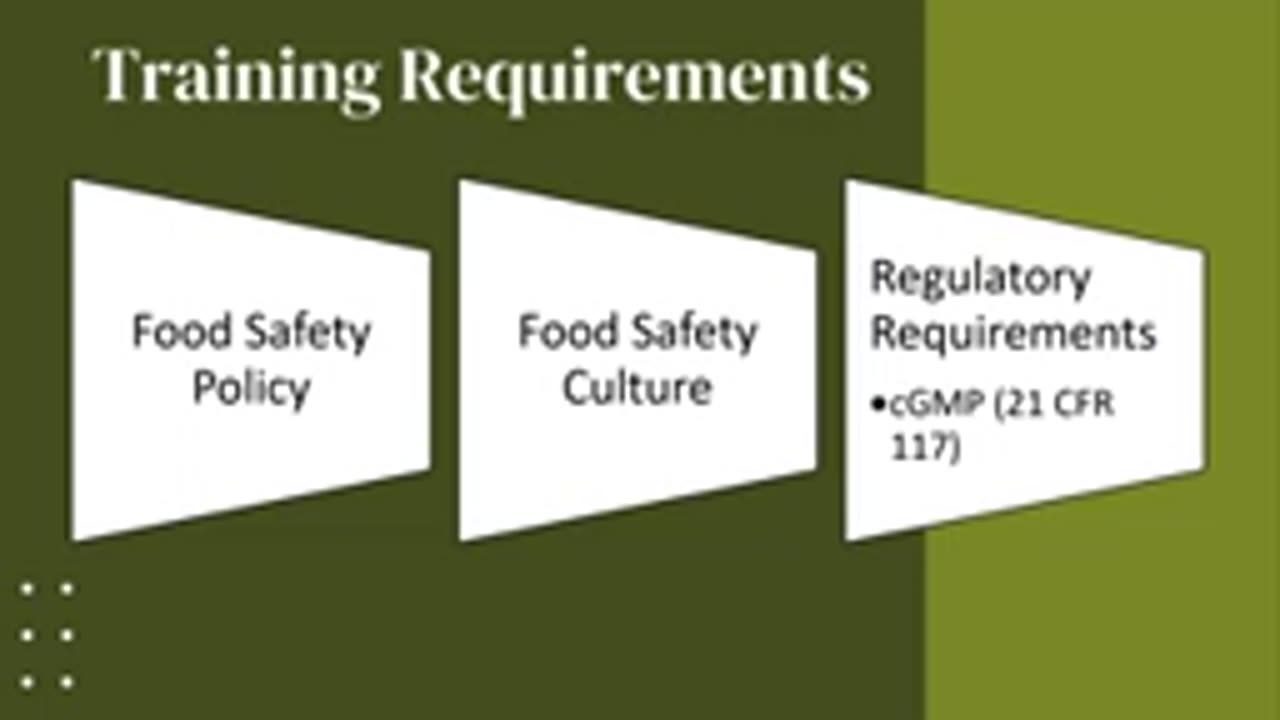Premium Only Content

Food Industry Training Requirements _ Food Safety Training
Here’s a detailed overview of **Food Industry Training Requirements** focused on **Food Safety Training**:
---
### **Purpose of Food Safety Training**
Food safety training ensures that all individuals involved in the food industry understand how to handle, prepare, store, and serve food safely, minimizing risks of contamination and foodborne illnesses.
---
### **Core Training Requirements for the Food Industry**
1. **Basic Food Hygiene and Handling**:
- **Target Audience**: All employees, from food handlers to managers.
- **Topics**:
- Personal hygiene (e.g., handwashing, use of gloves).
- Safe handling of raw and cooked food to prevent cross-contamination.
- Cleaning and sanitizing practices.
2. **Hazard Analysis and Critical Control Points (HACCP)**:
- **Target Audience**: Supervisors, quality control personnel, and management.
- **Topics**:
- Principles of HACCP, including hazard identification, critical control points, monitoring, and corrective actions.
- Risk assessment and documentation.
3. **Allergen Management**:
- **Target Audience**: Kitchen staff, food packagers, and servers.
- **Topics**:
- Identification of common allergens (e.g., nuts, gluten, shellfish).
- Prevention of allergen cross-contact.
- Accurate labeling and communication with customers.
4. **Food Safety Regulations**:
- **Target Audience**: Regulatory compliance officers and managers.
- **Topics**:
- Local, national, and international food safety standards (e.g., FDA, EU regulations, Codex Alimentarius).
- Licensing and certification requirements.
- Record-keeping and reporting protocols.
5. **Temperature Control**:
- **Target Audience**: Food storage and transportation personnel.
- **Topics**:
- Proper storage temperatures for raw and cooked foods.
- Use of temperature monitoring devices.
- Handling cold chain logistics to prevent spoilage.
6. **Emergency and Crisis Management**:
- **Target Audience**: Management and emergency response teams.
- **Topics**:
- Protocols for managing food recalls.
- Handling contamination incidents.
- Communication strategies during a food safety crisis.
7. **Advanced Microbiological Safety**:
- **Target Audience**: Quality assurance teams and lab technicians.
- **Topics**:
- Understanding foodborne pathogens.
- Sampling and testing procedures.
- Interpreting microbiological reports.
---
### **Types of Food Safety Training**
1. **Onboarding Training**: Mandatory for new employees before starting work.
2. **Periodic Refresher Training**: To update staff on the latest food safety regulations and technologies.
3. **On-the-Job Training**: Practical, role-specific training conducted at the workplace.
4. **Certification Courses**: Offered by recognized institutions (e.g., ServSafe, ISO 22000) to validate expertise in food safety.
5. **Specialized Training**: For niche industries (e.g., seafood processing, dairy production).
---
### **Legal Requirements**
- **Country-Specific Compliance**:
- United States: Compliance with FDA's Food Safety Modernization Act (FSMA).
- European Union: Adherence to EU Regulation No 852/2004 on food hygiene.
- India: Compliance with FSSAI guidelines.
- **Mandatory Certification**: In some regions, food handlers must acquire government-recognized food safety certification.
---
### **Challenges in Implementing Food Safety Training**
1. High turnover rates in the food industry.
2. Language barriers among diverse workforce groups.
3. Limited resources for training in small or developing food businesses.
4. Keeping up with rapidly evolving food safety standards.
---
### **Best Practices for Effective Food Safety Training**
1. **Interactive Learning**: Use videos, simulations, and real-life scenarios for better engagement.
2. **Multilingual Programs**: Provide training in the languages spoken by the workforce.
3. **Continuous Monitoring**: Regular assessments to ensure adherence to food safety practices.
4. **Technology Integration**: Leverage e-learning platforms for flexible training schedules.
---
Would you like this expanded into a formal guide, presentation, or tailored for a specific audience?
-
 1:01:17
1:01:17
The StoneZONE with Roger Stone
6 hours agoChristmas Edition: Why the Panama Canal is Part of the America First Agenda | The StoneZONE
40.4K17 -
 LIVE
LIVE
LFA TV
17 hours agoLFA TV CHRISTMAS EVE REPLAY
612 watching -
 LIVE
LIVE
tacetmort3m
1 day ago🔴 LIVE - THE ZONE KEEPS PULLING ME BACK - STALKER 2 - PART 15
1,102 watching -
 22:45
22:45
Brewzle
13 hours agoI Went Drinking In A Real Bourbon Castle
25.9K3 -
 48:36
48:36
PMG
1 day ago $1.87 earned"Parkland Parent Speaks Out On Kamala Harris Using Victims"
19.2K3 -
 4:06
4:06
The Lou Holtz Show
12 hours agoCoach Lou Holtz’s Heartfelt Christmas Message 🎄 | Family, Faith & Notre Dame Spirit 💚 #christmas
14.5K -
![ROSEANNE BARR - Her Journey, TRUMP, and the MAGA GOLDEN AGE! [INTERVIEW]](https://1a-1791.com/video/s8/1/M/m/B/2/MmB2v.0kob.1-small-ROSEANNE-BARR-Her-Journey-T.jpg) 51:35
51:35
Dr Steve Turley
1 day ago $17.95 earnedROSEANNE BARR - Her Journey, TRUMP, and the MAGA GOLDEN AGE! [INTERVIEW]
49.9K50 -
 57:38
57:38
The Tom Renz Show
10 hours agoMerry Christmas - The Tom Renz Show Christmas
87.8K16 -
 2:59:10
2:59:10
Wendy Bell Radio
21 hours agoThe Bridge Too Far
166K301 -
 1:03:45
1:03:45
Donald Trump Jr.
1 day agoHappy Festivus: Airing Our Grievances and Stopping The Swamp w/Sean Davis | TRIGGERED Ep.201
426K546